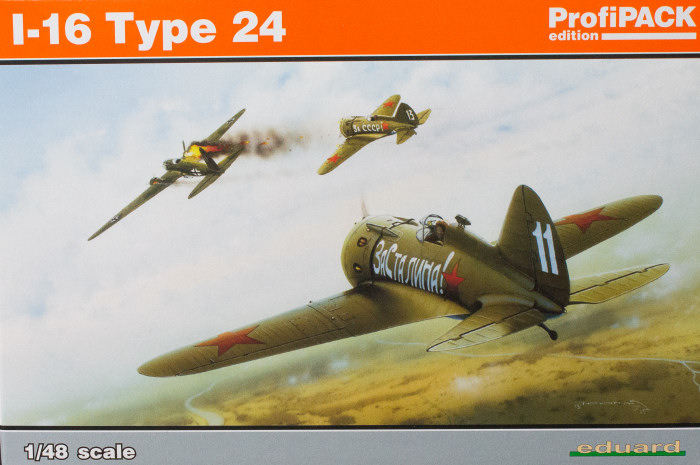
Eduard 1/48 Polikarpov I-16 Type 24 Kit First Look
By Michael Benolkin
| Date of Review | May 2015 | Manufacturer | Eduard |
|---|---|---|---|
| Subject | Polikarpov I-16 Type 24 | Scale | 1/48 |
| Kit Number | 8149 | Primary Media | Styrene, Photo-Etch |
| Pros | Very nicely detailed kit | Cons | See text |
| Skill Level | Intermediate | MSRP (USD) | $29.98 |
First Look
 |
 |
 |
Polikarpov's design signature during the mid and late 1930s was stubby, barrel-shaped fighters. The primary machine during that era was the I-15 biplane. Like their barrel-shaped brothers on the other side of the world, the Grumman F3Fs, the I-15 was going to be transformed almost directly into a monoplane fighter, the I-16. In the transformation, the I-15's upper wing was deleted and the lower wing strengthened to carry the full load. With a wingspan one meter shorter than the I-15, the early I-16 was powered by the same 700hp M-25 radial engine as the late-model I-15. The I-16 also incorporated retractable landing gear which could be exchanged for retractable skis. Armament for the I-16 Type 104 was a pair of 7.62mm machine guns in the top of the nose and another pair in the wings just outside the propeller arc. The Type 17 retained the nose-mounted machine guns, while the wing-mounted guns were replaced with 20mm cannons.
The I-16 saw combat on two fronts in the late 1930s, first in the Spanish Civil War and later with the Chinese against Japan. In Spain, the early Bf 109s flown by the Nationalists were surprised by the agile I-16 and suffered losses to the 'Rata' (Rat) as they nicknamed it. The Japanese forces were also surprised by the agile I-16 until they finally discovered and exploited the I-16's weaknesses. By 1941, the Type 24 had become the primary version in service featuring a more powerful engine, standard radio equipment, and strengthened landing gear. This became the main production version of the I-16 and was later updated to the Type 29 briefly before being removed from service.
Eduard first released this kit in 2006 and it remains the best I-16 kit in 1/48 scale. The kit is molded in gray styrene and presented on four parts trees, plus a tiny clear stub containing the windscreen. The kit is rounded out with a set of color-printed photo-etched parts.
Among the features and options in this kit:
- Beautifully detailed cockpit
- Choice of decal or color photo-etched instrument panel
- Positionable pilot entry doors
- Positionable engine cowling shutters
- Positionable rudder
- Detailed landing gear
While the kit has a positionable rudder, the elevators are molded in the neutral position on the horizontal stabilizers and likewise for the ailerons on the wings. If you want to position them other than neutral, careful surgery will be required.
Markings are provided for six aircraft:
- I-16, White 11, 'Za Stalina' (For Stalin)/'Smert' Fashistam' (Death to Facists)
- I-16, White 10, 'Smert' Fashizmu' (Death to Fascism)
- I-16, Red 21, 4 GIAP, Baltic Fleet AF, 1942
- I-16, Red 34, 4 GIAP, Baltic Fleet AF, 1941
- I-16, White 27, 254 IAP, Leningrad, 1942
- I-16, White 3, 69 IAP, Odessa, 1941
This is a beautiful kit with excellent details throughout. This kit remains the nicest I-16 available in 1/48 scale. What's more, Eduard released this reissue with the 2006 MSRP of about $30.00 USD. Nice!
My sincere thanks to Eduard for this review sample!







